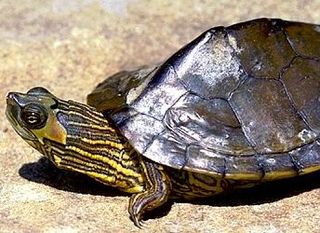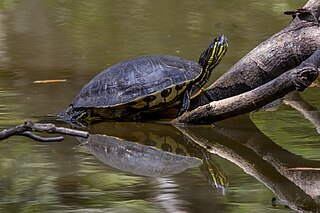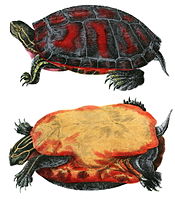
The red-eared slider or red-eared terrapin is a subspecies of the pond slider, a semiaquatic turtle belonging to the family Emydidae. It is the most popular pet turtle in the United States, is also popular as a pet across the rest of the world, and is the most invasive turtle. It is the most commonly traded turtle in the world.

Trachemys is a genus of turtles belonging to the family Emydidae. Members of this genus are native to the Americas, ranging from the Midwestern United States south to northern Argentina, but one subspecies, the red-eared slider, has been introduced worldwide. Species under this genus are commonly referred to as sliders.

The spotted turtle, the only species of the genus Clemmys, is a small, semi-aquatic turtle that reaches a carapace length of 8–12 cm (3.1–4.7 in) upon adulthood. Their broad, smooth, low dark-colored upper shell, or carapace, ranges in its exact colour from black to a bluish black with a number of tiny yellow round spots. The spotting patterning extends from the head, to the neck and out onto the limbs. Sexually mature males have a concave plastron and a long, thick tail. By contrast, sexually mature females possess a flat plastron and have a tail that is noticeably shorter and thinner than that of mature males. Mature males also have a dark iris and face; females typically have a yellow or orange iris and a similarly coloured face that is distinctly lighter than the males'. Juveniles appear female-like in this regard, and at maturity males begin to develop darker features.

The Texas river cooter is a species of freshwater turtle endemic to the U.S. state of Texas. It is found in the river basins of the Brazos, San Bernard, Colorado, Guadalupe, San Antonio, Nueces, and their tributaries. It is one of three species of cooters (Pseudemys) occurring in Texas, including the Rio Grande cooter and the river cooter.

The pond slider is a species of common, medium-sized, semiaquatic turtle. Three subspecies are described, the most recognizable of which is the red-eared slider, which is popular in the pet trade and has been introduced to other parts of the world by people releasing it to the wild. Hatchling and juvenile pond sliders have a green upper shell (carapace), yellow bottom shell (plastron), and green and yellow stripes and markings on their skin. These patterns and colors in the skin and shell fade with age until the carapace is a muted olive green to brown and the plastron is a dull yellow or darker. Some sliders become almost black with few visible markings. The carapace is oval with a bit of rounding and a central crest with knobs, but these features soften and fade with age, adults being smoother and flatter. For determining an adult slider's sex, males typically have much longer front claws than adult females, while females usually have shorter, more slender tails than males. Their lifespans range from 20 to 50 years.

The Caspian turtle, also known as the striped-neck terrapin, is a species of turtle in the family Geoemydidae (=Bataguridae). It is found in the eastern Mediterranean region from southwestern former USSR and central Iran to Saudi Arabia, Bahrain, Israel, and Lebanon, northward through Turkey to Bulgaria, and through Cyprus, Crete, and the Ionian Peninsula to former Yugoslavia.

The Cumberland slider, also called commonly the Cumberland turtle and Troost's turtle, is a subspecies of pond slider, a semiaquatic turtle in the family Emydidae. The subspecies is indigenous to the Southeastern United States.

The big-headed pantanal swamp turtle or pantanal swamp turtle is a species of turtle in the family Chelidae found in Brazil, Bolivia, Argentina, and Paraguay.

The East African black mud turtle, also known as the Pan terrapin, is a species of turtle in the family Pelomedusidae, native to eastern and southeastern Africa.
Dahl's toad-headed turtle is a medium-sized species of side-necked turtle in the family Chelidae. This critically endangered freshwater turtle is endemic to northern Colombia, where it lives in small pools, streams, and swamps, but aestivates on land.

The Hispaniolan slider or Haitian slider is a species of turtle in the family Emydidae found on the island of Hispaniola.

The yellow-bellied slider is a land and water turtle belonging to the family Emydidae. This subspecies of pond slider is native to the southeastern United States, specifically from Florida to southeastern Virginia, and is the most common turtle species in its range. It is found in a wide variety of habitats, including slow-moving rivers, floodplain swamps, marshes, seasonal wetlands, and permanent ponds. Yellow-bellied sliders are popular as pets. They are a model organism for population studies due to their high population densities.

The Alabama map turtle is a species of emydid turtle endemic to the southern United States. Differentiation from other turtle species includes a black stripe running down the center of its back with knobs extruding from it, but these projections wear down with age. T.H. Bean and L. Kumlen first collected the Alabama map turtle in July 1876 from a lake near Montgomery, Alabama. Type locality for this species is Montgomery County, Alabama. Baur described and named the Alabama map turtle in 1893. The genus Graptemys includes nine species of mostly aquatic turtles.

The Yaqui slider is a species of turtle belonging to the genus Trachemys of the family Emydidae. It is native to Chihuahua and Sonora in northwestern Mexico.

The Nicaraguan slider is a subspecies of turtle in the family Emydidae. The species is indigenous to Nicaragua and Costa Rica.

The ornate slider is turtle belonging to the genus Trachemys of the family Emydidae. It is found in Guerrero, Jalisco, Nayarit and Sinaloa in western Mexico.

The Cuatro Ciénegas slider, also known commonly as la jicotea de Cuatrociénegas in Mexican Spanish, is a species of turtle belonging to the genus Trachemys of the family Emydidae. The species is native to northeastern Mexico.

The Meso-American slider is a species of turtle belonging to the family Emydidae. The species is distributed from Mexico to Colombia.

The red-eared slider × yellow-bellied slider is an intergradation of a red-eared slider and yellow-bellied slider subspecies. Intergrade facial markings range from a yellow blotch behind each eye, which may join a yellow neck stripe forming a “C” figure when viewed from the left side to those with an almost indistinguishable amount of red in the eye blotch, to individuals that look similar to red-eared sliders with a red “ear” stripe that doesn’t join with a yellow neck stripe. In addition, the number of black blotches on the plastron varies in intergrades from two on the front scutes which is typical of yellow-bellied sliders, to a dark blotch on each scute which is typical of red-eared sliders. Intergrades are presumed to be omnivorous, but hatchlings and juveniles are more carnivorous than adults.



















